The homeownership rate—the percentage of households that own rather than rent the homes that they live in—has fallen sharply since mid-2005. In fact, in the second quarter of 2016 the homeownership rate fell to 62.9 percent, its lowest level since 1965. In this blog post, we look at underlying demographic trends to gain a deeper understanding of the large increase in the homeownership rate from 1995 to 2005 and the subsequent large decline. Although there is reason to believe that the homeownership rate may begin to rise again in the not-too-distant future, it is unlikely to fully recover to its previous peak levels. This is a disconcerting finding for those who view homeownership as an integral part of the American Dream and a key component of income security during retirement.
An estimate of the homeownership rate is published each quarter by the U.S. Census Bureau, based on a sample of housing units. A quarterly time-series of the not-seasonally-adjusted homeownership rate since 1965 is presented in the chart below. The first thing to catch the eye when looking at this chart is how much the homeownership rate rose over the period from the mid-1990s through 2005, and then how much it has declined since reaching a peak. The homeownership rate of 63.4 percent in the third quarter of 2016 is only modestly above the series low of 63.0 percent in the fourth quarter of 1965.
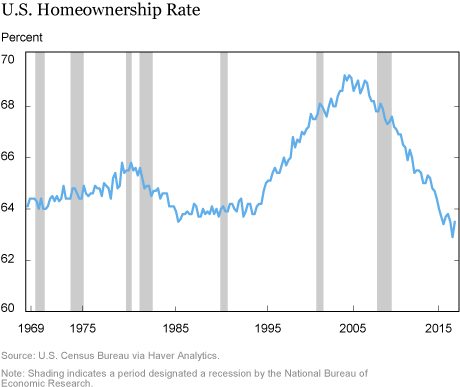
What explains the movements in the homeownership rate over the past two decades? A significant portion of the increase in the homeownership rate from the mid-1990s through 2005 occurred because of strictly demographic reasons. Over that period the population aged 45 and over grew at a 2.4 percent compound annual rate, while those aged 16 to 44 grew at only a 0.3 percent annual rate. Older people are more likely to establish their own household and to own the home they live in. Moreover, these highly skewed growth rates continued over the period from 2004 to 2015, with the number of people aged 16 to 44 growing again at 0.3 percent, while the group aged 45 and over grew at a rate of 1.7 percent. Thus, the true decline of the homeownership rate over the past decade should be measured relative to a counter-factual baseline in which that rate would have continued to increase as the population aged. Finally, as we documented in an earlier post, the large volume of home foreclosures in the wake of the financial crisis and Great Recession contributed to the decline in homeownership since 2004. However, we find evidence of a secular decline in homeownership for most age cohorts dating back to the early 1980s.
Some Useful Background
To begin, it would be useful to review a few key concepts. First, a household is any person or group of persons that occupy a housing unit. The headship rate is the number of households divided by the population. The number of households is the headship rate times the population, either in the aggregate, or as the sum of age-cohort-specific headship rates times the corresponding populations. Second, the homeownership rate is the number of owner-occupant households divided by the total number of households, again either in the aggregate or the sum over age cohorts. Finally, through substitution we can define the number of owner-occupant households as the homeownership rate times the headship rate times the population. We will look later at the product of the homeownership rate and the headship rate for age cohorts to reveal some interesting secular trends.
Major Changes in the Age Distribution of the Population
As shown in the chart below, over the past twenty years there have been major changes in the age distribution of the U.S. population. This chart presents age-specific shares of the population in 1994, 2004, 2015, and for 2025 as currently projected by the Census Bureau. As mentioned above, the population has gotten progressively older over the past two decades, with generally declining shares for people under the age of 45. This trend is projected to continue in the next decade, with the share of the population over age 65 rising rapidly.
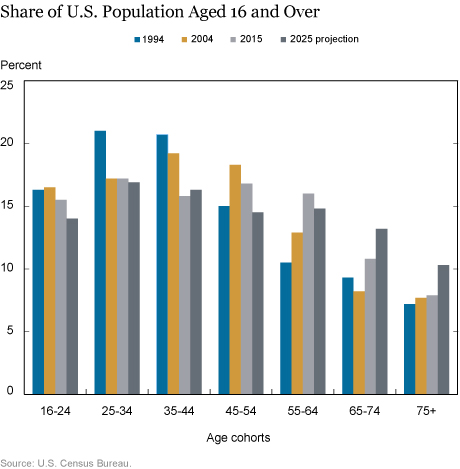
Declines in Many Age-Specific Headship Rates
The next chart presents the aggregate headship rate and age-cohort specific headship rates. Some key points to note are that headship rates increase with age, and so the aging of the population over the past two decades would result in a rising aggregate headship rate. This effect was largely offset by the fact that in several age cohorts, headship rates declined over this period.
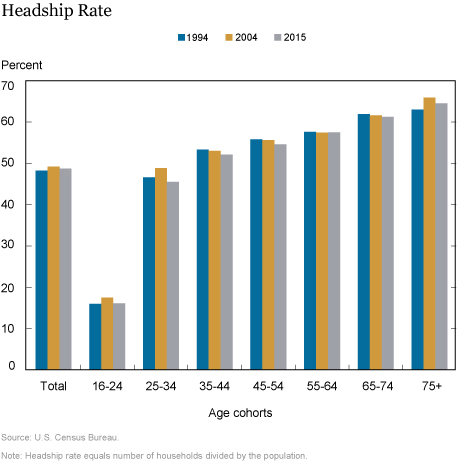
Even Larger Declines in Many Age-Cohort-Specific Homeownership Rates
As seen in the chart below, the aggregate homeownership rate in 2015 was not terribly different from what it was in 1994 at 63.7 percent versus 64 percent. But note that the 2015 homeownership rates for age cohorts from 25 all the way up to 64, were well below their 1994 levels. The only age cohorts for which homeownership rates increased were 16 to 24 and 75+. The fact that the aggregate homeownership rate was essentially unchanged from 1994 to 2015 indicates that the aging of the population offset these declines in age-specific homeownership rates.
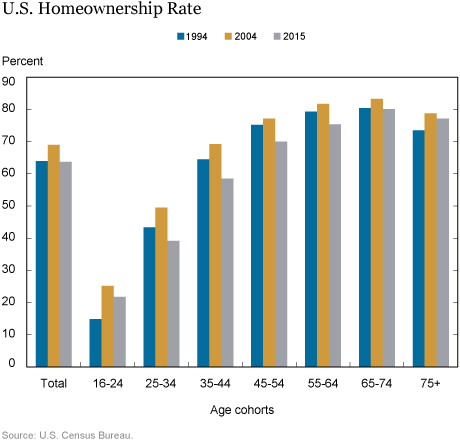
Counterfactual Paths for the Homeownership Rate
In the next chart we present some alternative paths for the homeownership rate based on varying assumptions for headship rates and homeownership rates. In the first case, shown in gold, we assume that all age-specific headship rates and homeownership rates remained at their respective peak values in 2003 and 2004, and then project the aggregate homeownership rate from 2004 through 2030 using the actual and projected changes in the age distribution of the population. Under this set of assumptions the homeownership rate in 2015 would have been 70.2 percent rather than 63.7 percent and would have reached 71 percent by 2030. Relative to that assumed path, there were 10.6 million or 11.7 percent fewer homeowners in 2015 with the bulk of the decline among households headed by someone aged 16 to 44.
An alternative path for the aggregate homeownership rate is one in which headship rates and homeownership rates are fixed at their 1994 levels, shown in the dark blue line. Relative to that path, the number of homeowners in 2015 was roughly 6 million or 7 percent lower. Finally, the gray line presents a path for the homeownership rate if headship rates and homeownership rates are fixed at their 2015 levels. Note that in all three cases, the aggregate homeownership rate is on an upward trend due to the aging of the population.
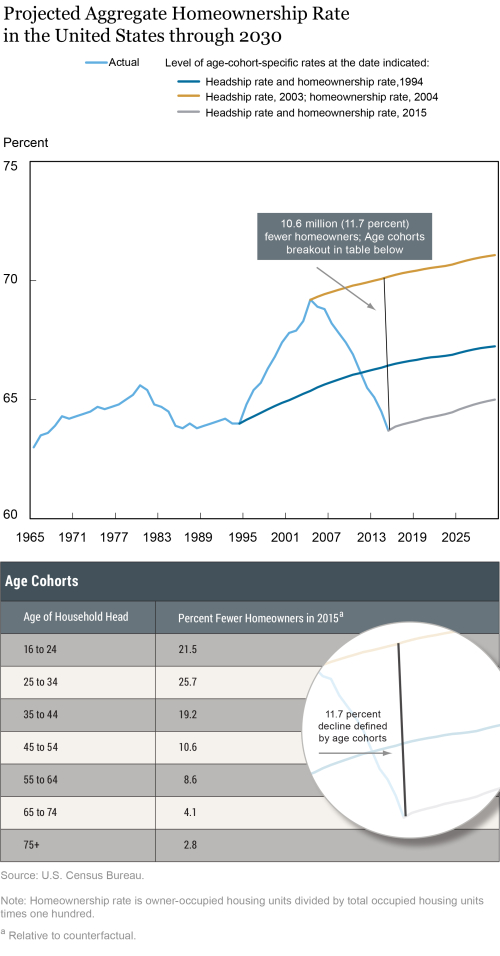
Secular Trends in the Incidence of Homeownership by Age
In the final chart, we present the headship rate times the homeownership rate by age cohort. This rate, which is simply the percentage of an age cohort who are homeowners, could be termed the incidence of homeownership. Note that from 1982 through 2015, this incidence measure is on a downward trend for age cohorts from 25 to 64, with the rate of decline slowing somewhat as one moves up the age distribution. For people aged 16 to 24 this incidence measure is stable but quite low, while for those 65 to 74 it is relatively stable but high. Only for those aged 75 and over has the incidence of homeownership increased over time.
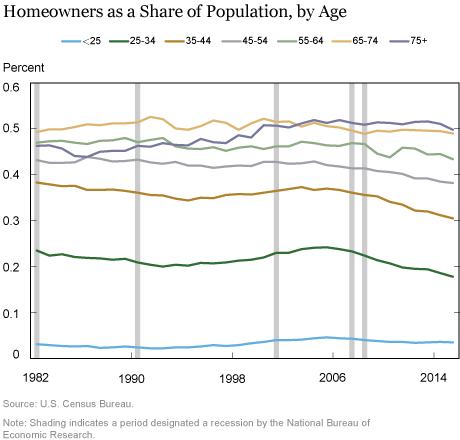
Conclusion
The aggregate homeownership rate rose from 64 percent in 1994 to a recent peak of 69 percent in 2004. That increase was driven by some increase in age-specific homeownership rates, more modest increases in age-specific headship rates, and, importantly, the ongoing aging of the population. The homeownership rate then plunged from 69 percent in 2004 to 63.7 percent in 2015 due to significant declines in age-specific headship rates and homeownership rates, particularly for those in the 25 to 54 age group. Note that this decline occurred during a period when the continued aging of the population was exerting upward pressure on the homeownership rate. Finally, there has been a secular decline in the incidence of homeownership for people aged 25 to 64. Why this secular decline is occurring is unknown. Some potential explanations are declining real incomes for some households and changes in tenure preferences, perhaps related to increased urbanization. No matter what the cause, however, our findings suggest that it is unlikely that the aggregate homeownership rate will rise very much in the next decade and a half absent a strong rebound in age-specific headship rates and homeownership rates
Disclaimer
The views expressed in this post are those of the authors and do not necessarily reflect the position of the Federal Reserve Bank of New York or the Federal Reserve System. Any errors or omissions are the responsibility of the authors.

Andrew F. Haughwout is a senior vice president in the New York Fed’s Research and Statistics Group.

Richard Peach is a senior vice president in the Bank’s Research and Statistics Group.

Joseph Tracy is an executive vice president and senior advisor to the president of the Federal Reserve Bank of New York.
How to cite this blog post:
Andrew F. Haughwout, Richard Peach, and Joseph Tracy, “A Close Look at the Decline of Homeownership,” Federal Reserve Bank of New York Liberty Street Economics (blog), February 17, 2017, http://libertystreeteconomics.newyorkfed.org/2017/02/a-close-look-at-the-decline-of-homeownership.html.











 RSS Feed
RSS Feed Follow Liberty Street Economics
Follow Liberty Street Economics
It’s interesting to see a discussion of home ownership in the United States without much mention of urbanization, home prices, labor wages, new home construction, or credit access. Is looking at the problem through age cohorts the least politically risky way?
Thank you for this very interesting look into the ever changing US economic, social landscape. I wonder to what extent the uncertain employment backdrop adds to this decline? Even in the backdrop of improving employment dynamics as evidenced by some US employment data, job security remains a concern. Perhaps this is a factor?